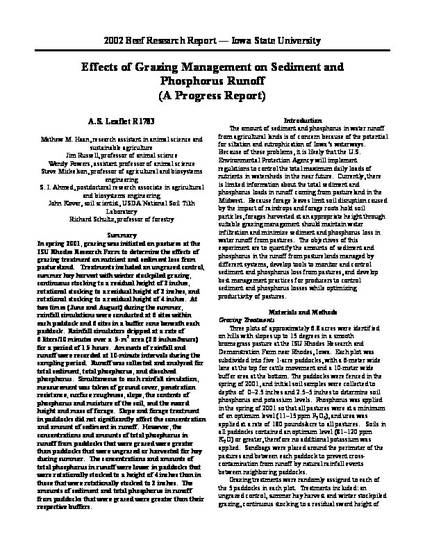
Unpublished Paper
Effects of Grazing Management on Sediment and Phosphorus Runoff (A Progress Report)
Beef Research Report, 2002
Extension Number
ASL R1783
Topic
Environmental Management
Publication Date
2003
Disciplines
Abstract
In spring 2001, grazing was initiated on pastures at the ISU Rhodes Research Farm to determine the effects of grazing treatment on nutrient and sediment loss from pastureland. Treatments included an ungrazed control, summer hay harvest with winter stockpiled grazing, continuous stocking to a residual height of 2 inches, rotational stocking to a residual height of 2 inches, and rotational stocking to a residual height of 4 inches. At two times (June and August) during the summer, rainfall simulations were conducted at 6 sites within each paddock and 6 sites in a buffer zone beneath each paddock. Rainfall simulators dripped at a rate of 6 liters/10 minutes over a .5-m2 area (2.8 inches/hours) for a period of 1.5 hours. Amounts of rainfall and runoff were recorded at 10-minute intervals during the sampling period. Runoff was collected and analyzed for total sediment, total phosphorus, and dissolved phosphorus. Simultaneous to each rainfall simulation, measurement was taken of ground cover, penetration resistance, surface roughness, slope, the contents of phosphorus and moisture of the soil, and the sward height and mass of forage. Slope and forage treatment in paddocks did not significantly affect the concentration and amount of sediment in runoff. However, the concentrations and amounts of total phosphorus in runoff from paddocks that were grazed were greater than paddocks that were ungrazed or harvested for hay during summer. The concentrations and amounts of total phosphorus in runoff were lower in paddocks that were rotationally stocked to a height of 4 inches than in those that were rotationally stocked to 2 inches. The amounts of sediment and total phosphorus in runoff from paddocks that were grazed were greater than their respective buffers.
Copyright Date
2003
Language
en
File Format
PDF
Citation Information
Matthew M. Haan, Jim Russell, Wendy Powers, Steven K. Mickelson, et al.. "Effects of Grazing Management on Sediment and Phosphorus Runoff (A Progress Report)" (2003) Available at: http://works.bepress.com/richard_schultz/5/
